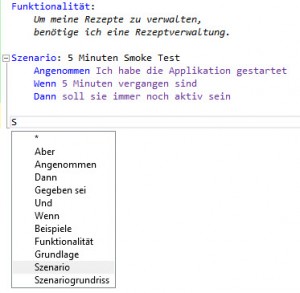Da Requirements die Grundlage der Entwicklung und somit auch der Kommunikation mit dem Kunden und innerhalb des Teams sind, lohnt es sich in einigen Fällen diese in der Muttersprache des Kunden zu verfassen um Missverständnissen vorzubeugen. Gherkin bzw. Specflow unterstützen dies in dem die Feature Dateien in über 40 unterschiedlichen Sprachen erstellt werden können. Dazu gehört, wer hätte es gedacht, auch Deutsch.
Um dieses Feature einzuschalten ist auch nicht sonderlich viel Arbeit notwendig. Tatsächlich muss nur eine App.Config im entsprechenden Projekt hinterlegt werden die folgenden Inhalt hat.
<?xml version="1.0" encoding="utf-8"?>
<configuration>
<configSections>
<section name="specFlow" type="TechTalk.SpecFlow.Configuration.ConfigurationSectionHandler, TechTalk.SpecFlow" />
</configSections>
<specFlow>
<language feature="de-DE" />
</specFlow>
</configuration>
Die eigentliche Magie passiert durch das „language“ Element dem über Feature das Kürzel der zu verwendenden Kultur anzugeben ist. Darüber hinaus gibt es noch ein Attribut „tool“ mit dem es theoretisch möglich sein soll auch die Fehlerausschriften, und damit zum Beispiel die Beschreibungen über nicht implementierte Features, zu übersetzen. Praktisch ist dies aber aktuell nicht möglich, da nur Englisch unterstützt wird.
Nachdem die App.config gespeichert wurde, schaltet Specflow sofort in die neue Sprache und funktioniert wie gewohnt, einschließlich Autovervollständigung.




